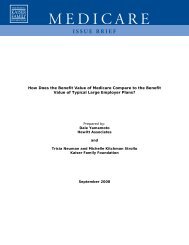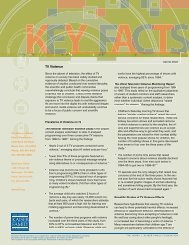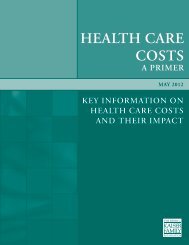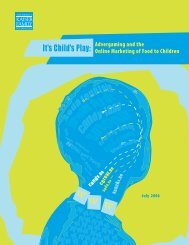Sex Ed Issue Update.indd - The Henry J. Kaiser Family Foundation
Sex Ed Issue Update.indd - The Henry J. Kaiser Family Foundation
Sex Ed Issue Update.indd - The Henry J. Kaiser Family Foundation
Create successful ePaper yourself
Turn your PDF publications into a flip-book with our unique Google optimized e-Paper software.
According to a recent <strong>Kaiser</strong> <strong>Family</strong> <strong>Foundation</strong> study, nine out<br />
of ten (89%) of the nation’s nearly 20 million public secondary<br />
school students will take sex education at least once between<br />
the 7th and 12th grades. 1 Yet what students learn can vary<br />
widely.<br />
Across the nation, states have passed a patchwork of sex<br />
education laws, ranging from general mandates that the<br />
subject be taught to more specifi c guidelines regarding topics<br />
or messages to be included. <strong>The</strong> AIDS epidemic led a number<br />
of states to pass specifi c requirements to provide some form of<br />
education about the prevention of HIV/AIDS in particular and/<br />
or sexually transmitted diseases (STDs) in general. Because most<br />
state laws governing these topics are fairly broad, the specifi c<br />
content of the curriculum is often left to local school districts or<br />
individual schools.<br />
<strong>The</strong> federal government’s involvement in sex education has<br />
primarily been to provide funding for education programs – a<br />
role that has grown in recent years. As part of its response to<br />
the HIV/AIDS epidemic, the budget for the Centers for Disease<br />
Control and Prevention (CDC) has included funding for HIV<br />
education since 1988. In 1996, as part of its broad welfare<br />
reform package, Congress made signifi cant federal funds<br />
available over a fi ve-year period to promote abstinence-only<br />
messages through community-based and in-school programs.<br />
In the coming year, federal, state, and local lawmakers will look<br />
at education spending in a new context of shrinking budgets.<br />
Congress is expected to debate whether to reauthorize funding<br />
for several abstinence-only programs, and the outcomes of this<br />
federal discussion will likely infl uence further state and local<br />
action on sex education.<br />
This issue brief examines the federal, state, and local policies<br />
that guide approaches to sex education today. It also examines<br />
recent research into community-level experiences and<br />
practices, as well as emerging evidence about the eff ectiveness<br />
of diff erent types of sex education curricula.<br />
Approaches to <strong>Sex</strong> <strong>Ed</strong>ucation<br />
Comprehensive or “Abstinence Plus”<br />
Comprehensive curricula include information about both<br />
abstinence and contraception. Sometimes a comprehensive<br />
curriculum may be referred to as “abstinence plus” because<br />
it teaches abstinence as the preferred choice. Advocates of<br />
comprehensive sex education argue that while young people<br />
should be taught to remain abstinent until they are emotionally<br />
and physically ready for sex, information about<br />
U p d a t e<br />
I s s u e<br />
<strong>Sex</strong> <strong>Ed</strong>ucation in the U.S.: Policy and Politics<br />
U p d a t e<br />
birth control and disease prevention is essential for those who<br />
are sexually active. 2<br />
Abstinence-only<br />
Abstinence-only sex education teaches abstinence until<br />
marriage as the only option for teenagers. Proponents of<br />
abstinence-only education argue against any discussion or<br />
education about contraception and safer sex, asserting that<br />
this sends young people a mixed message that contradicts the<br />
absolute prescription of abstinence – thus encouraging sexual<br />
activity. 3<br />
While the particulars of what is taught may vary, sex education<br />
is often described as presenting either an “abstinence-only”<br />
or “comprehensive” message. According to national surveys,<br />
most Americans support a more comprehensive approach<br />
to sex education: 81 percent say schools should both teach<br />
abstinence and give teens enough information to help them<br />
prevent unplanned pregnancies and the spread of STDs if<br />
they do decide to have sex;18 percent support teaching only<br />
abstinence until marriage. 4<br />
<strong>Sex</strong> <strong>Ed</strong>ucation in Practice<br />
October 2002<br />
A nationwide survey of principals, conducted by the <strong>Kaiser</strong><br />
<strong>Family</strong> <strong>Foundation</strong> in 1999, found that some form of sex<br />
education is taught in the vast majority of public secondary<br />
schools (95%). 5 Most principals – 58 percent – describe their sex<br />
education curriculum as comprehensive, that is “young people<br />
should wait to have sex but if they do not they should use birth<br />
control and practice safer sex.” A third (34%) say their school’s<br />
main message is abstinence-only, that is “young people should<br />
only have sex when they are married” (Figure 1).<br />
Percent Of Public Secondary School Principals<br />
Reporting That <strong>The</strong>ir Schools’ Main Message<br />
Of <strong>Sex</strong> <strong>Ed</strong>ucation Is….<br />
34%<br />
8%<br />
58%<br />
Figure 1<br />
Comprehensive<br />
Abstinence-only<br />
Other<br />
SOURCE: <strong>Kaiser</strong> <strong>Family</strong> <strong>Foundation</strong> National Survey of Public Secondary School Principals. 1999
According to the 2000 Federal School Health <strong>Ed</strong>ucation Profi les<br />
study, the median percentage of schools off ering required<br />
health education courses to students in grades 6 to 12 was 91<br />
percent. Among these schools, a large percentage said that<br />
they tried to increase knowledge of HIV (96%) and pregnancy<br />
prevention (84%). 6<br />
Federal Policy<br />
HIV/AIDS <strong>Ed</strong>ucation<br />
In response to the public health threat presented by the AIDS<br />
epidemic, the Centers for Disease Control and Prevention (CDC)<br />
has provided funding and technical assistance specifi cally<br />
for HIV education since 1988. 7 In 2000, the CDC budgeted<br />
approximately $47 million for in-school HIV education, which<br />
is just one piece of its larger prevention eff orts. In-school HIV<br />
education funds are directed toward strengthening national<br />
eff orts for coordinated school health education, training<br />
180,000 teachers annually in eff ective strategies for HIV/STD<br />
education, as well as supporting HIV education for youth in 48<br />
states, U.S. territories, the District of Columbia, and 18 major<br />
cities. 8 Ohio and Utah are the only states that do not accept HIV<br />
education funding from the CDC.<br />
Most of the CDC funding for in-school HIV education goes<br />
toward the education of students in high schools or middle<br />
schools, although some money goes toward HIV education<br />
eff orts aimed at college students and at-risk youth who are not<br />
in schools. Most of the recipients are state and local education<br />
agencies, although other national organizations receive funds<br />
as well. Programs and schools that receive the CDC funding<br />
must agree to have their curriculum reviewed by a committee<br />
which is supposed to follow the Guidelines for Eff ective<br />
School Health <strong>Ed</strong>ucation to Prevent the Spread of AIDS, which<br />
recommend a comprehensive curriculum. 9<br />
Abstinence-only <strong>Ed</strong>ucation<br />
Federal support for abstinence-only education eff orts began<br />
in 1981 with passage of the Adolescent <strong>Family</strong> Life Act (AFLA),<br />
whose primary stated goal is to prevent premarital teen<br />
pregnancy by establishing “family-centered” programs to<br />
“promote chastity and self discipline.” 10 It also seeks to promote<br />
adoption as the preferred option for pregnant teens and to<br />
provide support services for adolescents who are pregnant or<br />
parenting. In AFLA’s fi rst year, Congress authorized $11 million<br />
to be spent, in part, on promoting abstinence. Since then, the<br />
program has been refunded annually at between $6 and $18<br />
million, 11 with last year’s appropriation providing $12 million for<br />
the eff ort. 12<br />
A much more substantial amount of funding for abstinenceonly<br />
education was allocated in 1996 under the auspices of the<br />
Personal Responsibility and Work Opportunity Reconciliation<br />
Act, welfare reform legislation best known for the sweeping<br />
revisions it made to public assistance programs (including<br />
replacing the Aid to Families with Dependent Children—<br />
AFDC—with a new program, Temporary Assistance to Needy<br />
Families, TANF).<br />
<strong>The</strong> omnibus bill, which amended portions of Title V of the<br />
Social Security Act, provided $250 million in federal funds to the<br />
states allocated over a fi ve-year period (fi scal year 1998 through<br />
fi scal year 2002) to support abstinence-only programs, for both<br />
teens and unmarried adults.<br />
To qualify for Title V money, states must match every four<br />
dollars in federal funds with three dollars of state money,<br />
thus directing as much as $437.5 million to abstinence-only<br />
programs by the time the initial funding cycle ended in the fall<br />
of 2002. <strong>The</strong> legislation also provides a detailed defi nition of<br />
what federally funded programs are expected to teach (Table<br />
1).<br />
In 2000, Congress approved a separate abstinence-only “setaside”<br />
for community organizations as part of the maternal and<br />
child health block grants. <strong>The</strong>se “Special Projects of Regional<br />
and National Signifi cance Community-Based Abstinence<br />
<strong>Ed</strong>ucation” (SPRANS) initially received $40 million in earmarked<br />
funds over a two-year period. 13 Under SPRANS, grants are<br />
awarded directly by a federal agency, not by governors or state<br />
agencies; it also does not require that local funds match federal<br />
donations, thus potentially allowing greater access to the funds.<br />
Congress is expected to renew funding for all three of the<br />
current federal abstinence-only initiatives during the fi scal year<br />
2003 appropriations process, particularly given President Bush’s<br />
strong support of these programs. In fact, abstinence-only<br />
advocates have urged the President to hold to his promise to<br />
provide as much federal funding for abstinence programs as is<br />
provided to family planning programs that serve adolescents,<br />
which some estimate received $135 million in fi scal year 2001. 14<br />
Table 1<br />
Defi nition of “Abstinence”<br />
Under federal law, abstinence funds are available only to those<br />
programs that teach:<br />
§ Abstinence has social, psychological, and health benefi ts<br />
§ Unmarried, school-age children are expected to abstain<br />
from sex<br />
§ Abstinence is the only certain way to prevent out-ofwedlock<br />
pregnancy and sexually transmitted diseases<br />
§ A mutually faithful and monogamous married<br />
relationship is the standard for sexual activity<br />
§ <strong>Sex</strong>ual activity outside marriage is likely to have harmful<br />
psychological and physical eff ects<br />
§ Out-of-wedlock childbearing is likely to harm a child, the<br />
parents, and society<br />
§ How to reject sexual advances and how alcohol and drug<br />
use increases vulnerability to them<br />
§ <strong>The</strong> importance of attaining self-suffi ciency before<br />
engaging in sex<br />
Source: Section 510 (b), Title V of Social Security Act.
State Policy<br />
Despite these federal eff orts, education policy is mostly<br />
decentralized. And, since states may have multiple policies<br />
governing the teaching of sex education, the overall policy<br />
picture is fairly complex. For example, states that require that<br />
sex education be taught may vary considerably in terms of<br />
what, if any, curriculum they specify. Meanwhile, a state that<br />
has no specifi c policy on sex education may still “recommend”<br />
that educators take a particular course of action or even specify<br />
that a school district opting to off er sex education adhere to a<br />
particular curriculum.<br />
Even within an individual state, there may be diff ering policies<br />
governing mandates for education about contraception or<br />
abstinence and instruction on HIV/AIDS and other STDs. In<br />
fact, more states require schools to off er specifi c HIV or STD<br />
education than general sex education. It is also common for<br />
states to have diff erent requirements for students in diff erent<br />
grade levels. <strong>The</strong>se policy distinctions among and within states<br />
are often lost in the larger debate about sex education.<br />
As of September 2002, 22 states require that students receive<br />
sex education and 39 require HIV/STD instruction: 15<br />
• Twenty-two (22) states require schools to provide both<br />
sex education as well as instruction on HIV/STDs (AK,<br />
DE, FL, GA, HI, IL, IA, KS, KY, ME, MD, MN, NV, NJ, NC, RI,<br />
SC, TN, UT, VT, WV, WY).<br />
• Seventeen (17) states require instruction about HIV/<br />
STDs, but not sex education (AL, CA, CT, ID, IN, MI, MS,<br />
NH, NM, NY, ND, OH, OK, OR, PA, WA, WI).<br />
• One state requires sex education, but not STD<br />
instruction (ME).<br />
Specifi c requirements about what should be taught are also<br />
on the books in a number of states. Thirty (30) states require<br />
local school districts that off er sex education to teach about<br />
abstinence: Eight require that it be covered (CT, DE, FL, GA, KY,<br />
MI, VT, VA) and twenty-two require that it be stressed (AL, AZ,<br />
AK, CA, HI, IL, IN, LA, MD, ME, MS, MO, NC, NJ, OK, OR, RI, SC, TN,<br />
TX, UT, WV). In addition, thirteen of these states require local<br />
school districts that do off er sex education to cover information<br />
about contraception (AL, CA, DE, HI, MD, MO, NJ, OR, RI, SC, VT,<br />
VA, WV), but no state requires that birth control information be<br />
emphasized.<br />
Thirty-four states (34) give parents some choice as to whether<br />
or not their children can receive sex education or STD<br />
instruction (AL, AZ, CA, CT, FL, GA, ID, IL, IA, KS, LA, MD, MA,<br />
ME, MI, MN, MS, MO, MT, NJ, NY, NC, OK, OR, PA, RI, SC, TN, TX,<br />
VT, VA, WA, WV, WI). 16 Most of these states give parents the<br />
option of withdrawing their children from the courses. Three of<br />
these states (AZ, NV, UT) say that parents must actively consent<br />
before the instruction begins, while one of these (AZ) has an<br />
opt-out policy for STD education while requiring parental<br />
consent for sex education. Of the states with “opt-out” policies,<br />
fi ve require that it be due to a family’s religious or moral beliefs.<br />
Local Policy<br />
Even when state policy on sex education exists, signifi cant<br />
latitude and oversight is left to local school districts. 17 A<br />
national survey of school superintendents, conducted in 1998<br />
by the Alan Guttmacher Institute (AGI), found that more than<br />
two-thirds (69%) of U.S. school districts have a policy to teach<br />
sex education. 18 <strong>The</strong> remaining 31 percent leave the decisions<br />
about whether to teach such curriculum to individual schools.<br />
However, a disproportionate number of students reside in the<br />
districts with policies to teach sex education.<br />
Among districts with a policy, 14 percent report that their<br />
policy takes a “comprehensive” approach, teaching abstinence<br />
as one possible option for adolescents; 51 percent promote<br />
“abstinence-plus,” that is abstinence as the preferred option but<br />
allowing discussion of contraception as eff ective in protecting<br />
against pregnancy and disease; and the remaining third (35%)<br />
have an “abstinence-only” policy.<br />
When asked to name the single most important factor<br />
infl uencing district policy, an average of 48 percent of<br />
superintendents cite state directives. Special committees and<br />
school boards were named as infl uential about equally often<br />
(18% and 17%, respectively).<br />
Similarly, the large majority of public secondary school<br />
principals (88%) in the 1999 <strong>Kaiser</strong> <strong>Family</strong> <strong>Foundation</strong> study<br />
report that school districts and local governments have at least<br />
“some infl uence” on their schools’ sex education curricula. 19<br />
Seventy percent (70%) report that state government has at<br />
least “some infl uence,” and 31 percent report that the federal<br />
government’s abstinence-only funds had at least “some<br />
infl uence” at the time the survey was conducted. Principals<br />
also note that the content of sex education in public secondary<br />
schools is subject to at least some local or state guidelines<br />
(85%), including four in 10 principals (43%) who term the<br />
guidelines as “strict.”<br />
When a specifi c topic is not taught in sex education, principals<br />
often cite a school or district “policy.” For example, the leading<br />
reason given by principals for not covering abortion and sexual<br />
orientation was a school or district “policy,” followed closely by<br />
actual or perceived pressure from the community.<br />
Community Involvement<br />
Beyond government policy and public offi cials, principals<br />
report that several other groups are involved in deciding what<br />
is covered in their schools’ sex education curricula. More than<br />
half of principals (57%) say teachers are “very involved” and<br />
one in four (23%) say parents are as equally involved. Other<br />
members of the community (15%) and religious leaders (11%)<br />
are less frequently named.
One in two (48%) principals say there have been recent<br />
“discussions or debates at the PTA, school board, or other public<br />
meetings” on some aspect of sex education, from what to teach<br />
to how parents give permission. However, most (58%) report<br />
no change in curriculum as a result. <strong>The</strong> highly publicized issue<br />
of whether to teach an abstinence-only curriculum was the<br />
most commonly named specifi c topic, but was a subject of<br />
discussion in fewer than one third (31%) of schools. Debate<br />
over abstinence-only curriculum was equally likely to have<br />
occurred in schools with a comprehensive curriculum as in<br />
those that emphasized abstinence as the only option (Figure 2).<br />
Percent of Principals Reporting Discussions or<br />
Debates in Recent Years About...<br />
Whether sex ed classes should<br />
be single-sex or coed<br />
Whether or not to teach<br />
abstinence-only<br />
What topics to teach in sex ed<br />
How parents give permission<br />
for sex ed<br />
Teaching abstinence-only<br />
Evaluating Eff ectiveness<br />
Figure 2<br />
Congress has approved $6 million for a national evaluation<br />
of abstinence eff orts funded under the 1996 welfare law. 20<br />
Additionally, within the fi rst two years of the federal program,<br />
at least 39 states indicated that they had plans to conduct some<br />
form of evaluation of their own eff orts, using a portion of the<br />
funds they were receiving from the federal government. 21<br />
<strong>The</strong> federally funded eff ort – a rigorous, large-scale study of<br />
abstinence-only programs in fi ve states (FL, MS, SC, VA, WI)<br />
– is now underway. 22 Researchers will examine the types of<br />
programs that have emerged in response to the Title V funds<br />
and requirements and measure the impact of diff erent curricula<br />
and program models on diff erent behaviors and outcomes<br />
among students who participate in them. Behaviors and<br />
outcomes of interest would include whether students have sex,<br />
their exposure to STDs, and rates of adolescent pregnancies<br />
and births. <strong>The</strong> due date for this evaluation is 2005, and interim<br />
fi ndings are being released periodically before that fi nal report<br />
is completed.<br />
In the meantime other work is underway to examine the impact<br />
of diff erent sex education approaches. Many public and private<br />
groups have weighed in on the debate over what type of sex<br />
education is most eff ective.<br />
<strong>The</strong> Offi ce of the Surgeon General released a “Call to Action to<br />
Promote <strong>Sex</strong>ual Health and Responsible <strong>Sex</strong>ual Behavior” in<br />
16%<br />
17%<br />
26%<br />
26%<br />
31%<br />
0% 10% 20% 30% 40%<br />
Total = 313 principals<br />
SOURCE: <strong>Kaiser</strong> <strong>Family</strong> <strong>Foundation</strong> National Survey of Public Secondary School Principals. 1999<br />
June 2001 that noted that “more research is clearly needed”<br />
on abstinence-only programs, but that research on programs<br />
that cover both abstinence and contraceptive methods “gives<br />
strong support to the conclusion that providing information<br />
about contraception does not increase adolescent sexual<br />
activity, either by hastening the onset of sexual intercourse,<br />
increasing the frequency of sexual intercourse, or increasing the<br />
number of sexual partners.” <strong>The</strong> report encourages education<br />
that “assure[s] awareness of optimal protection from sexually<br />
transmitted diseases and unintended pregnancy for those<br />
who are sexually active, while also stressing that there are no<br />
infallible methods of protection, except abstinence, and that<br />
condoms cannot protect against some forms of STDs.” 23<br />
In May 2001,<strong>The</strong> National Campaign to Prevent Teen Pregnancy<br />
released a report analyzing “impact evaluations” of more<br />
than 100 adolescent pregnancy prevention programs (both<br />
abstinence-only and comprehensive). 24 This research, which<br />
was cited in the Surgeon General’s report, found that sex<br />
education programs can assist in preventing teen pregnancy,<br />
and noted that comprehensive programs that promote<br />
abstinence and provide information about contraceptive<br />
methods do not increase the frequency of sex or number of<br />
sex partners among adolescents – nor do they lower the age at<br />
which teenagers fi rst have intercourse. At the same time, the<br />
analysis found, when adolescents do become sexually active,<br />
such programs can apparently increase the likelihood that they<br />
will use contraception.<br />
<strong>The</strong> National Campaign selected eight programs that<br />
demonstrated a high evidence of success. Five were specifi c<br />
sex education programs; two were “service learning” programs<br />
that are meant to address what are considered “nonsexual<br />
antecedents” of teen pregnancy (such as detachment from<br />
school); and one was a general program that off ered sex<br />
education as part of a larger package of social services. <strong>The</strong><br />
most eff ective program, <strong>The</strong> Children’s Aid Society-Carrera<br />
Program, was also the most comprehensive, with sex education<br />
as one of many components, including individual tutoring,<br />
sports and art activities, work-related activities, and health care<br />
services. It was also an expensive program, costing up to $4,000<br />
per student.<br />
In its review of the research literature, the report found only<br />
three published evaluations of abstinence-only programs that<br />
it considered rigorous enough to be included in the analysis.<br />
None of these three evaluations found either an overall impact<br />
on sexual behavior or an eff ect on contraceptive use among the<br />
sexually active students in their programs. As a result, the report<br />
concludes that there is still not enough evidence available<br />
to assess the eff ectiveness of abstinence-only education<br />
programs.<br />
Additional copies of this publication (#3224-02) are<br />
available on the <strong>Kaiser</strong> <strong>Family</strong> <strong>Foundation</strong> website at<br />
www.kff .org.
<strong>The</strong> <strong>Henry</strong> J. <strong>Kaiser</strong> <strong>Family</strong> <strong>Foundation</strong>: 2400 Sand Hill Road, Menlo Park, CA 94025<br />
(650) 854-9400 Facsimile: (650) 854-4800<br />
Washington Office: 1450 G Street, N.W., Suite 250, Washington, D.C. 20005<br />
(202) 347-5270 Facsimile: (202) 347-5274<br />
Request for Publications: (800) 656-4533 http://www.kff.org<br />
<strong>The</strong> <strong>Henry</strong> J. <strong>Kaiser</strong> <strong>Family</strong> <strong>Foundation</strong>, based in Menlo Park, California, is an independent national<br />
health care philanthropy and is not associated with <strong>Kaiser</strong> Permanente or <strong>Kaiser</strong> Industries.<br />
R e f e r e n c e s<br />
e n c e s R e f e r<br />
e n c e s<br />
1 <strong>Kaiser</strong> <strong>Family</strong> <strong>Foundation</strong>, <strong>Sex</strong> <strong>Ed</strong>ucation in America: A Series of National<br />
Surveys of Students, Parents, Teachers, and Principals, September 2000.<br />
2 <strong>Sex</strong>uality Information and <strong>Ed</strong>ucation Council for the United States<br />
(SIECUS). (1998). Fact Sheet: <strong>Sex</strong>uality <strong>Ed</strong>ucation in the Schools: <strong>Issue</strong>s and<br />
Answers. New York: SIECUS.<br />
3 <strong>Family</strong> Research Council, <strong>Sex</strong> education: What works? In Focus,<br />
November 1995. http://www.frc.org/infocus/if95k2ab.html.<br />
4 <strong>Kaiser</strong> <strong>Family</strong> <strong>Foundation</strong>/ABC Television, <strong>Sex</strong> in the 90s: 1998 National<br />
Survey of Americans on <strong>Sex</strong> and <strong>Sex</strong>ual Health.<br />
5 <strong>Kaiser</strong> <strong>Family</strong> <strong>Foundation</strong> National Survey of Public Secondary School<br />
Principals on <strong>Sex</strong> <strong>Ed</strong>ucation, 1999.<br />
6 Centers for Disease Control and Prevention, CDC Surveillance Summaries,<br />
August 18, 2000. MMWR 2000;49 (No. SS-8).<br />
7 Richards, CL & D Daley, Politics and policy: Driving forces behind sexuality<br />
education in the United States. In Drolet & Clark (<strong>Ed</strong>s.), <strong>The</strong> <strong>Sex</strong>uality<br />
<strong>Ed</strong>ucation Challenge: Promoting Healthy <strong>Sex</strong>uality in Young People. Santa<br />
Cruz: ETR Associates, 1994.<br />
8 Centers for Disease Control and Prevention. School Health Programs: An<br />
Investment in our Nations’s Future. At-A-Glance 1999. Atlanta: CDC.<br />
9 Centers for Disease Control and Prevention, Guidelines for Eff ective<br />
School Health <strong>Ed</strong>ucation to Prevent the Spread of AIDS, MMWR 37(S-2);1-<br />
14, January 29, 1988.<br />
10 Saul R, Whatever Happened to the Adolescent <strong>Family</strong> Life Act? <strong>The</strong><br />
Guttmacher Report on Public Policy, Vol. 1, no. 2, April 1998.<br />
11 Offi ce of Population Aff airs, http://www.hhs.gov/progorg/opa/titlexx/<br />
oapp.html.<br />
12 Budget of the United States Government, Fiscal Year 2003, http:// http://<br />
www.whitehouse.gov/omb/budget<br />
www.whitehouse.gov/omb/budget. (Proposed)<br />
13 See http://www.hrsa.gov/Newsroom/NewsBriefs/2002/<br />
02budgettable.htm<br />
14 Meckler L, Bush seeks more for abstinence education, Associated Press,<br />
January 31, 2002, and National Journal, September 8, 2001.<br />
15 State information listed in this section is taken from <strong>The</strong> Alan Guttmacher<br />
Institute, State Policies in Brief: State <strong>Sex</strong>uality <strong>Ed</strong>ucation Policy, December<br />
1, 2002, and Gold RB and E Nash, Special Analysis: State-Level Policies on<br />
<strong>Sex</strong>uality, STD <strong>Ed</strong>ucation, <strong>The</strong> Guttmacher Report on Public Policy, Vol. 4,<br />
No. 4, August 2001.<br />
16 This data is reported but not shown in the article Gold RB and E Nash,<br />
Special Analysis: State-Level Policies on <strong>Sex</strong>uality, STD <strong>Ed</strong>ucation, <strong>The</strong><br />
Guttmacher Report on Public Policy, Vol. 4, No. 4, August 2001.<br />
17 National School Boards Association, A Call to Action: What Schools<br />
Can Do to Prevent Teen Pregnancy and Promote Student Achievement,<br />
Washington D.C., December 9-10, 1998. See www.nsba.org<br />
18 Landry DJ, L Kaeser and CL Richards, School District Policies on<br />
Abstinence Promotion And on the Provision of Information About<br />
Contraception, <strong>Family</strong> Planning Perspectives, Vol. 31, No. 6, November/<br />
December 1999.<br />
19 <strong>Kaiser</strong> <strong>Family</strong> <strong>Foundation</strong> National Survey of Public Secondary School<br />
Principals on <strong>Sex</strong> <strong>Ed</strong>ucation, 1999.<br />
20 Balanced Budget Act of 1997, P.L. 105-33, Section 5001(a)(1)<br />
Part H.<br />
21 Association of Maternal and Child Health Programs, Abstinence<br />
<strong>Ed</strong>ucation in the States – Implementation of the 1996 Abstinence<br />
<strong>Ed</strong>ucation Law. February 1999.<br />
22 See http://www.mathematica-mpr.com/3rdLevel/abstinence.htm<br />
23 <strong>The</strong> Surgeon General’s Call to Action to Promote <strong>Sex</strong>ual Health and<br />
Responsible <strong>Sex</strong>ual Behavior, June 2001. http://www.surgeongeneral.gov/<br />
library/sexualhealth/default.htm<br />
24 Kirby D, Emerging Answers: Research Findings on Programs to Reduce<br />
Teen Pregnancy, Washington DC: National Campaign to Prevent Teen<br />
Pregnancy, May 2001.












